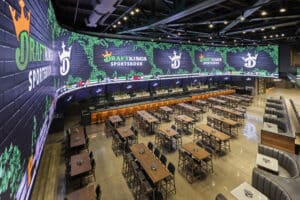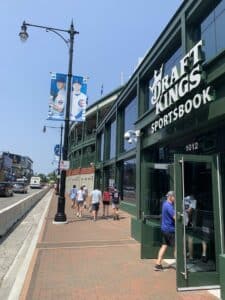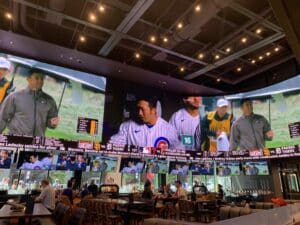GAME ON: Wrigley Field’s new sportsbook, branded for DraftKings, opened on June 27. Gensler designed the two-story building attached to the Chicago Cubs’ ballpark. (Don Muret/Staff)
Wrigley model for DraftKings’ sports venue biz
CHICAGO — The new DraftKings Sportsbook at Wrigley Field marks the brand’s first brick-and-mortar betting space tied to a sports venue and provides the Chicago Cubs with a lucrative year-round revenue source apart from baseball.
The sportsbook opened on June 27 along Addison Street, next to the right-field gate. The $25 million project cost was privately financed between DraftKings and Wrigley Field Holdings. The Ricketts family owns the Cubs and the ballpark.
To this point, the 23,000-square-foot, two-story sportsbook is restricted to bar and restaurant service. Patrons can still place bets on their mobile devices, which is permitted across the state of Illinois after legislators legalized sports betting in 2019.
DraftKings is in the process of applying for a sports betting license with the Illinois Gaming Board, said company spokesman Stephen Miraglia, which is required before it can take bets at kiosks inside the sportsbook.
It’s unclear when the gaming board would approve DraftKings’ license, but it could potentially be a lengthy process, considering United Center, home of the NBA Bulls and NHL Blackhawks, has yet to secure a license for the arena’s FanDuel Sportsbook. Almost one year has passed since FanDuel’s application was filed on Aug. 10, 2022, according to the IGB website. United Center executives Terry Savarise and Joe Myhra did not return emails to update the situation.
All told, the DraftKings Sportsbook at Wrigley Field joins other sportsbooks run by gaming entities connected to arenas and stadiums in Washington D.C., Phoenix, Arizona and Cincinnati, Ohio.
On its own, DraftKings’ second sportsbook is planned for TPC Scottsdale, the Arizona golf course that plays host to the PGA Tour’s Waste Management Open. The project broke ground in December and the 12,000-square-foot facility is scheduled to open this fall across the street from the course.
The Wrigley Field location serves as the model for future DraftKings sportsbooks, anchored by a giant videboard distributing sports betting content, project officials said.

BRICKS & IVY: Wrigley Field’s new sportsbook can fit about 675 patrons. (Neil John Burger Photography)
It’s a key piece of activation for DraftKings’ marketing deal with the Cubs, which drove the project, said Eric Nordness, managing principal for Marquee Development, the developer group owned by the Rickets. The Cubs declined to provide financial terms, but multiple gaming sites have reported it to be a $100 million sum over 10 years.
“We want this to feel like a great Chicago neighborhood tavern and one of the first places you think about to go watch that major event,” Nordness said. “For us, it was about having the big 2,000-square-foot screen over a two-story space. We thought it was critical to differentiate it from other sports bars in the area.”
The sportsbook can accommodate about 675 people, distributed among the standard bar stools, tables and chairs on the ground floor and the mezzanine level on the second floor. It’s open daily, including 9 a.m. to 2 a.m. on Friday and Saturday, but hours fluctuate depending on how busy it is, said Jeff Denlea, vice president of hospitality strategy for Levy, Wrigley Field’s concessionaire that runs the book’s food service. Patrons must be 21 years of age and IDs are checked at the door to enforce the policy.

GREEN SPACE: The design of Wrigley Field’s new sportsbook had to be approved by multiple historic preservation groups. (Don Muret/Staff)
On a Sunday morning in late July, two hours before the Cubs-Cardinals game, several tables were reserved for groups to eat lunch and watch the final round of The Open golf tournament in Liverpool, England on the massive videoboard before heading inside the ballpark.
There’s roughly 17,000 square feet of space devoted to the food and drink operation. Levy’s full-service kitchen is on the mezzanine level. The vendor employs about 80 workers in total, covering the bar, restaurant and kitchen spaces. That number will increase during football season to meet what’s expected to be increased demand, Denlea said.
The sportsbook food menu is higher end compared with the typical concessions inside the ballpark. Items are priced accordingly, running, for example, from $17 for the Colossal Hot Dog, to $19 for the BBQ Bourbon Burger and $24 for the Smoked Prime Rib Sandwich.
Beer prices are $7.50 for domestic cans to $12 for local craft selections. About a half-dozen crafts are on draft, served in three sizes, extending from $9 to for Krombacher Pilsner to $70 for the self-serve beer tower in four flavors, including 3 Floyds Gumballhead, an American pale wheat.
The sports betting piece sits to the left as people enter the facility. On that particular Sunday, a gentleman sat behind the DraftKings branded counter as a security measure to protect a restricted area, Miragila said.
Ticket holders for Cub games and concerts must exit the sportsbook and go through the stadium gates to get their tickets scanned. Conversely, fans inside the ballpark that want to visit the sportsbook must leave and come through the new building’s front door on Addison.
“We’re getting great feedback,” Denlea said. “People are excited for football season to kick off, to come and watch multiple NFL Sunday games at the same time. We haven’t seen any cannibalization (siphoning food/drink revenue from the park itself). You can’t get this vibe anywhere other than Vegas.”

BETS OFF: There’s not much to do for DraftKings until the sports betting firm is licensed at Wrigley Field. (Don Muret/Staff)
DraftKings teamed with Marquee and Levy to develop the sportsbook on a site which has gone through several iterations over the past 40 years, including a DraftKings branded lounge under a previous agreement.
Gensler, the same architect that designed the Caesars Sportsbook at Capital One Arena, the country’s first sports betting space physically connected to a sports venue, planned the Wrigley Field version.
Pepper Construction, general contractor for the $760 million reconstruction of Wrigley Field completed in 2018, built the sportsbook over 14 months.
McCann Systems (audio-visual) and TriMark USA (food service design) were also part of the project team.
Rick Fawell, Gensler’s project director in Chicago, is familiar with Wrigley Field from his tenure at VOA Associates, which helped design previous ballpark upgrades. Fawell said officials visited sportsbooks in Las Vegas, Reno and Atlantic City, and consulted with Gensler’s office in Vegas that’s done work on those venues and knows all the aspects for successfully programming those facilities.
At the same time, officials worked closely with historic preservation groups in Chicago, the state of Illinois and at the federal level to get approval on the design of the new building attached to Wrigley Field, which has certain pieces such as the iconic red marquee protected under landmark status with the National Park Service.
The result is a new addition whose exterior steel frame is painted the same traditional forest green color that adorns much of the ballpark’s infrastructure and seating bowl. The project team had to be careful to plan the addition without altering the existing facade and there were multiple tweaks made to the exterior and the entrance to avoid designing “one long monotonous facade and no articulation,” Fawell said.
“At first, (preservation groups) were suspect of the idea, in the sense that it feels like somebody’s just trying to grab more space to make more money,” he said. “It wasn’t really that; it had more to do with developing a proper sportsbook that could function efficiently and had the food and beverage they needed to support it.”

CURVEBALL: The sportsbook’s signature videoboard curves around both ends of the bar to create an immersive experience. (Don Muret/Staff)
Inside the sportsbook, as Nordness mentioned, the signature element is the expansive videoboard, which can show 25 games simultaneously, with a scrolling screen beneath it displaying betting odds, player injuries and other information pertinent to sports bettors. Produced by Nanolumens, the board spans 134 feet long and 15 feet high, curved at both ends as it wraps around the bar.
“It becomes an immersive experience and no seat ends up being a bad seat,” Fawell said. “It’s set up to compete with food and drink offerings along Addison.”
Large mirrored windows provide street views from inside the sportsbook, capturing all the activity on Cub game days.
Marquee Development consults with other teams to develop entertainment districts, including the Minnesota Twins, and officials have taken several clubs through the sportsbook to get ideas for what they could do in their respective markets.
From a mixed-use perspective, the sportsbook is among the three elements other teams are looking for, along with live music venues and “food as entertainment” with recreational activities such as darts, golf and bowling as they plan their own entertainment districts, Nordness said.
“It’s going to be market dependent, but if you’ve got an urban district with different restaurants and entertainment venues, it will be one of the go-to options, focusing on the audio-visual and experiential aspects,” he said.
Editor’s Note: This story has been revised since it was published.







